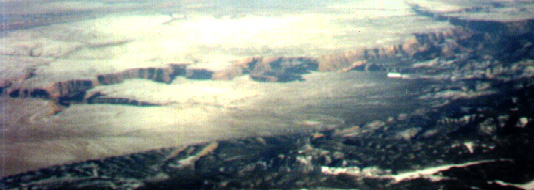 The Grand Canyon
The Grand Canyon 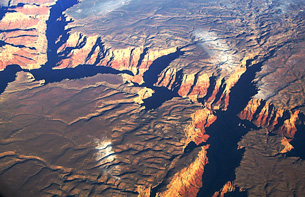
Two different means of protecting nature and natural resources are preservation and conservation.
 The Grand Canyon
The Grand Canyon 
![]() John Wesley Powell, 1878,
Plan for the Arid Regions.
John Wesley Powell, 1878,
Plan for the Arid Regions.
Other visionaries | Roosevelt's vision | Contrasts | Public trust doctrine | Disease prevention | Use | Ecology | Summary
Reclamation through irrigation of farmlands along the Colorado River on the California & Arizona border.
Key reiteration
![]()
For understanding the protection of land and water, there is a set of competing philosophies concerning the development of an environmentally sound approach to wildlife, fisheries, rivers, and public lands. One is the preservationist bent of mind and the other is a conservationist impulse.
"consider the weightiest problem now before the Nation; and the occasion for the meeting lies in the fact that the natural resources of our country are in danger of exhaustion if we permit the old wasteful methods of exploiting them longer to continue."
". . . .But of late the rapidity of the process has increased at such a rate that more space has been actually covered during the century and a quarter occupied by our national life than during the preceding six thousand years that take us back to the earliest monuments of Egypt, to the earliest cities of the Babylonian plain."
President Theodore Roosevelt's 1908 speech, "Conservation as a National Duty," Washington, D.C.
Other visionaries | Roosevelt's vision | Contrasts | Public trust doctrine | Disease prevention | Use | Ecology | Summary
![]()
The underlying differences are slight, but definitive.
| preservationist | conservationist |
| traditional | progressive |
| scenic beauty | utilitarian * irrigation surveys |
| recreation and contemplation | reclamation and reservoirs |
| preserve | conserve |
| retain without diminishing the original value | to keep from harm, loss, or decay |
"In this fight among scientists, engineers, and practitioners to define the best means of protecting the landscape to support even greater numbers of people, a more life-centered approach to protecting fish and bird habitats emerged called biologically centered values, or biocentric perspectives to challenge simple views based on use of resources."
Marshes of the Ocean Shore, p. 64.
Other visionaries | Roosevelt's vision | Contrasts | Public trust doctrine | Disease prevention | Use | Ecology | Summary
![]()
* Utilitarian means using for the greatest good for the greatest number; In conservation terms, utilitarian means the wisest use for the largest number of users over the longest period of time. For that reason, sustained yield forestry was a conservation practice that seeks to protect the watershed by growing timber, as one would a crop, but harvesting only what is needed when the trees are mature, and leaving nurse logs for new growth to recover after felling the trees for timber. Ecologically speaking, the reforestation of timbered landscapes can be less than optimal for wildlife and fisheries if the older, slower growing timber is replaced by a different species because it may mature more quickly and be harvested sooner. For example, yew trees or redwood trees of the Pacific maritime forests are often replaced by Douglas fir trees, because they grow swiftly, But the animal life of the forests is altered when fir replaces yew and redwood forests.
The Earth's remaining forests are due, in part, to conservation efforts.
Other visionaries | Roosevelt's vision | Contrasts | Public trust doctrine | Disease prevention | Use | Ecology | Summary
Ecology is derived from the Greek words oikos + logos:
oikology used by Thoreau in his journals and coined (1866) by Ernst Haeckel -- a German biologist and Darwinian scholar. He based his new word on Darwin's (1859) distinction between the "organic and inorganic conditions of existence."
Ecology | ecosystems | ecosystem services | ecological integrity
Federal surveys began before the Civil War but burgeoned after the war, moving from surveying navigable rivers, to determining the species of mammals, fish, and birds, while identifying the geology of the western region.
Addison Verrill described fresh, brackish, and salt water fish.Santa Rosa Island, Florida utilitarian conservation of live oak trees and forests for naval shipbuilding and defense. (1828)Environmental ideal of fish and (bird) wildlife protection.
John Marshall's Gibbons vs. Ogden decision, 1826, defined a national interest in navigable waterways.
The sources of conservation can be traced to Colonial wildlife regulations or game laws were often created and enforced for hunting purposes to provide marginal citizens with food; this was particularly true of fishing.
Tidelands as a public trust for purposes of navigation, fishing and hunting.
Hydrodynamics of scour for channel maintenancelegal opinions of the public trust doctrine and inalienability of submerged lands
Common benefits of navigable waterways.
The public domain is defined
as all land west of the Appalachian mountains ceded to the federal government,
by the states in 1785 in order to create new territories and states.
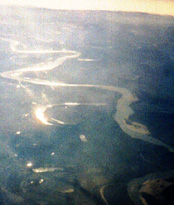
![]() • Mississippi River in the late afternoon.
• Mississippi River in the late afternoon.
Swamplands acts 1848-1850 made reclamation or drainage and levee building a federal priority.
Upland and upriver swamp reclamation aggravated flooding down river.Decline in fisheries.
Charles Ellet and the survey of the Mississippi River
1852 Report Survey.
| Ellet had a watershed and multi-state perspective to solve the river's siltation and flood problems. | ||
|
Technological remedy to correct the impacts of settlement, policy and bad laws. California rivers had similar problems of flooding and greater silt and sediment deposition. |
||
|
Levees were essential to prevent flooding on the Sacramento River. Seen here with trees along the opposite bank, the levee is both a natural feature of rivers and an enhanced human engineering of the floodplain to protect dwellers from floods. |
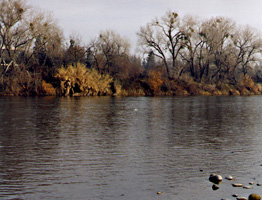 |
|
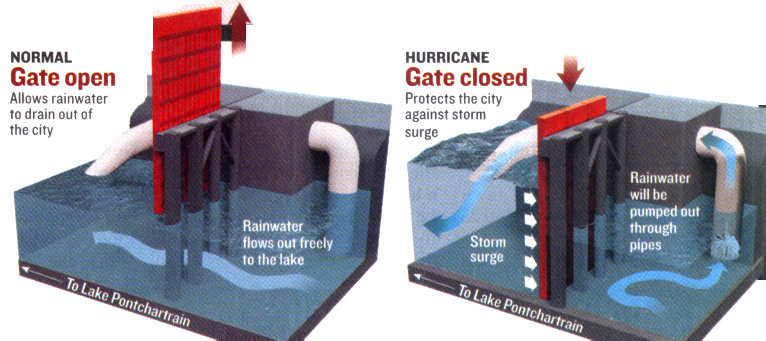 |
Levees required coordinated efforts which were often lacking. Floods are natural occurrences and come in cycles, but the extent, duration, and height (or depth) of the flood's waters are exacerbated by the removal of forests and swamplands.
|
|
Other visionaries | Roosevelt's vision | Contrasts | Public trust doctrine | Disease prevention | Use | Ecology | Summary
|
||
Cholera epidemics swept through in 1832, 1849, & 1866, pointing up bad water quality
|
||
| Flood control, flood-plain planning, and public health protection all required a comprehensive view. |
Even when flood control to protect human settlements and property by use of extensive civil engineering is practiced, preventing rivers from flooding once wetlands are drained and forests are cut is impossible . |
|
Frederick Law Olmsted Sr. (landscape engineer) and George Waring (sanitary engineer) had such a vision. |
||
Urban parks and sanitation reform both advocated a communal vision that moved beyond a mere concern for personal wealth through the accumulation of private property.
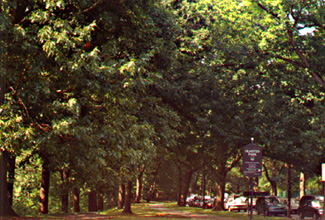
Both preserving park lands and conserving forests for timber and water protection rely on this communal vision of how best to utilize, protect, and forestall the waste of resources on common lands, submerged lands, river beds, or swamps.
See for example Olmsted's vision.

Parkway created in Boston to extend city parks into the urban residential areas of 19th century cities.
Frederick Law Olmsted recognized the organic constraints of topography, slope, soil character, drainage and vegetation in his designs for urban and wild parks: NYC & Yosemite from 1857 to 1865. He later applied his acquired knowledge to the Boston regional park plan, part of which is seen above, to protect forests, fens, and wetlands.
Technology of sewers, parkways and parks was the instrument of civic rejuvenationRecognized the need to engineer in order to restore "disturbed harmonies" induced by population, settlements, industry and waste.George Waring and sanitary engineering as a civic duty
State police power to protect and promote public health.
When people who were landowners were left to their own private means of disposing of waste, trash and garbage, cities encountered problems of improper disposal and contaminated water wells. Sickness from putrefaction and cholera from contaminated well required cities like New York, New Orleans. Philadelphia, and Boston to act, as London had done before them to promote healthy disposal of human waste and garbage.
Other visionaries | Roosevelt's vision | Contrasts | Public trust doctrine | Disease prevention | Use | Ecology | Summary
George Perkins Marsh, local and international sense of place; the transformation of desert grasslands from over grazing of cattle is palpable.
e
Marsh, Man and Nature, 1864, was a pioneering work on how humans alter the geography often to their own demise.
The Connecticut River, painted here, flows through five states.
• Marsh asked himself which of the five states would have the greatest impact on the fisheries of this multi-state river?
• Would it be the one with the conservation of forests, or the one which allowed the timbering of steep slopes and drainage of wetlands?
When rivers flow through many states, the quality of the water needed by fisheries and wildlife is often most affected adversely by the jurisdiction with the worst land-use practices.
Marsh, Powell, Ellet and Olmsted form a powerful organic approach to understanding human impact on natural features and the limitations these impose on societies.
"Marsh's appeal for geographical regeneration significantly altered the attitudes of specialists toward land legislation, river policies, and wildlife conservation laws."Their ideas reflected a systemic understanding of land as a series of biotic communities, and these ideas appeared before such attitudes were commonplace among scientific specialists."
p. 82
Other visionaries | Roosevelt's vision | Contrasts | Public trust doctrine | Disease prevention | Use | Ecology | Summary
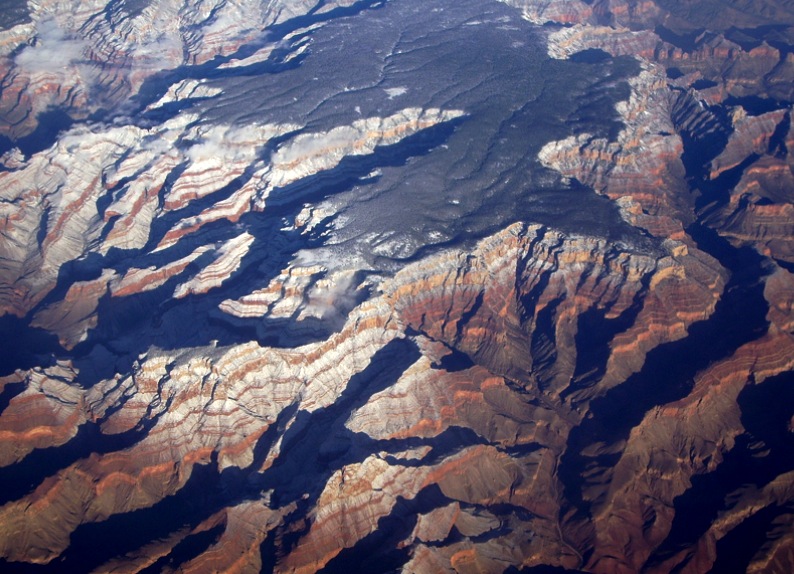
So we must know that conservation is the downstream equivalent of the upstream preservation in both a literal and abstract sense. And thus Round River is enhancing the ecological integrity in the ethical protection of the environment.
By that I mean sustained-yield forestry or fishery practices makes no sense without, in one case, preserving the soil and, in he other case, preserving the water quality.
Round River by Aldo Leopold
Past lessons: Settlement.
landscape
index ![]() words index
words index ![]() photograph index
photograph index